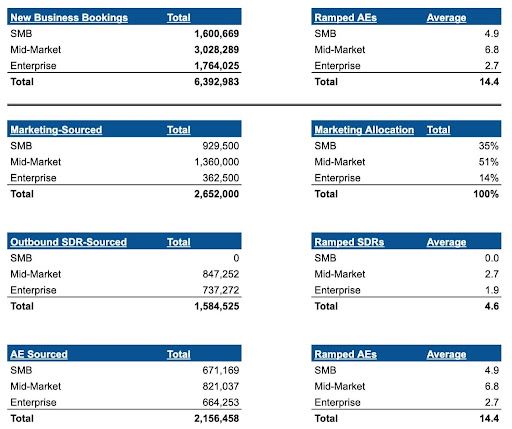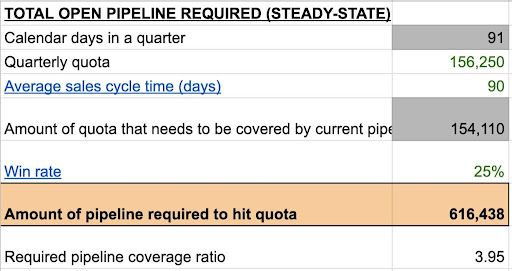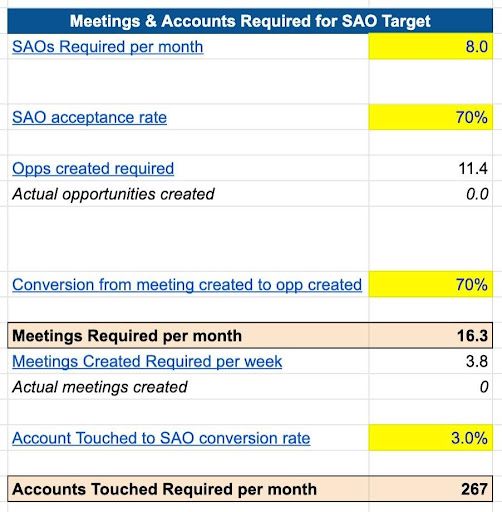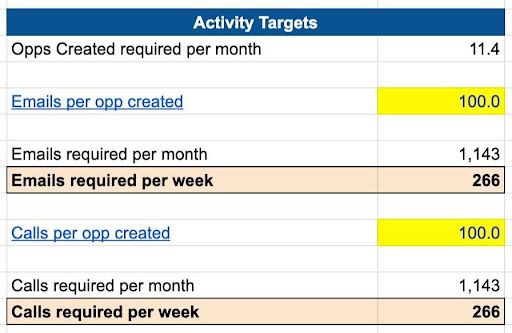To run a data-driven goal setting exercise, you have to actually have data around what is and isn’t working. As I mentioned in my discussion of onboarding and ramping new hires, this process starts with the targets you want individual sales reps to achieve. Then you work backwards from those outcomes to the required inputs so you can set relevant goals and, most importantly, make sure those goals set your team up to hit quota.
When to Re-evaluate Your Team’s Sales Goals
- Reality isn’t aligning to current goals and you need to reset expectations.
- Your sales motion has changed.
- Your product, offering or place in the market has changed.
- You’ve recently introduced new training or tools that you expect to impact sales effectiveness.
- It’s been more than six months since you last evaluated your goals.
Your Metrics Depend on Your Team
The most important metrics to set goals against will depend upon the sales teams you’re managing. Each role will have different key metrics. Goals against those metrics will be most effective across varying time periods.
Reflect on the activities your sales reps spend the majority of their time performing. What are the most important core tasks you ask your team to execute in order to achieve quota? For instance, AEs may spend most of their time meeting with customers (either virtually or in-person) while SDRs may spend the majority of their time making phone calls or emailing with prospects. These factors should be pretty good indicators of what you want to measure.
You’ll also want to think about the team you manage; different roles will care about varying outcomes across a span of time frames. Bookings for a small business account executive (AE) are generally measured per month because those roles tend to have high-velocity sales cycles in which reps close multiple transactions each month. A mid-market AE may measure bookings by quarter while an enterprise AE, who might only close a handful of high-dollar deals across the course of the year, will probably measure annually.
Keep in mind: Some metrics are better than no metrics.
New opportunities created by inbound sales development representatives (SDRs) — who are primarily qualifying marketing-generated leads — might be measured as often as weekly. On the other hand, outbound SDRs cold prospecting into enterprise and mid-market organizations may measure opportunities created per month.
There will also be different leading indicator metrics that comprise the most important inputs to generating these outcomes, which will also differ by role. For AEs, these metrics may include meetings held and new opportunities entering their pipeline across all sources, while for SDRs you might measure the number of new accounts or new contacts touched.
Keep in mind: Some metrics are better than no metrics. Occasionally, organizations will make the mistake of spending time debating over which metrics are the best ones when they could have started with a set of basics to reap immediate gains, and then started to tune over time.
What Should the Goal Be?
When undertaking a goal-setting exercise, start by defining your desired outcomes. What are the total bookings expected of the organization? How does that translate into quota per AE? How much of that quota are the SDRs expected to generate? Define what success looks like and break those goals down by your measurement period. Once you know what the overall expectations are, you can start to work backwards to other goals you might want to set for your team.
Here’s an example of total bookings and headcount expectations, broken down by source and customer segment. This is something your finance team may share as a result of annual planning efforts:

You can see that there are different expectations for total bookings and bookings per AE by customer segment, and that the expected source of those bookings changes as well.
For AEs, the key is to understand the sales velocity formula, which states bookings for a given time period will be equal to the number of opportunities worked in that time period multiplied by the win rate on opportunities multiplied by the average size of won opportunities, all divided by the average sales cycle time. In other words:
Bookings [per period] = (# opps worked * win rate * average deal size) / average sales cycle time
Once you understand each of the elements of this formula, you can use the same elements to set goals around metrics like total pipeline owned or total number of new opportunities that need to be added to an AE’s pipeline each month.
Here’s an example of how the math works out:


When we know an AE’s quota and the average sales cycle time of a deal, that will tell us how many dollars in bookings we need to generate from the amount of open pipeline at any given time. If we then factor in the percentage of pipeline we expect to win, we know how much total pipeline the AE needs to carry.
Similarly, we can work backwards to set a goal for new opportunities or new pipeline. If we know the quota, we can divide it by the average selling price of a single deal to understand how many deals the AE needs to win to hit quota. Then we can apply the win rate to understand how many total new opportunities we need to reach that number of won deals.
We can apply the same logic to SDRs. If an SDR’s quota is equal to X sales accepted opportunities (SAOs) per month, you can look at the total opportunities created and the acceptance rate of those opportunities. You can then look at the ratio of key inputs to opportunities created to set goals for those inputs.
Here’s an example that uses an SDR team’s existing conversion rates to calculate the level of prospecting activities each SDR needs to complete.


You can apply this approach regardless of the specific metrics you choose.
Tracking Progress
Once you know what your targets are for key metrics, it’s important to track them and review them regularly so the team understands the expectations clearly and how to meet those goals. This means you need to incorporate a metrics review as part of your one-on-ones and team meetings.
When Should I Reevaluate Goals?
Obviously, goals will change as the realities of the business change, but here are some key indicators that it may be time to revisit your team’s goals:
Reality Isn’t Aligning to Current Goals
If you’re partway through the year, and marketing or SDR are coming in significantly above or below what was expected, that may change expectations for the AE team for the remainder of the year.
Your Sales Motion Changed
If you have shifted your sales efforts, either up market to larger target customers or down market to smaller customers, that may impact the ability for different parties to meet their commitments and therefore result in a need to adjust expected behaviors or outcomes. Even if overall expected contributions to the pipeline remain the same, that pipeline may comprise more or fewer opportunities if there’s been a shift in the ideal customer profile.
Your Product, Offering or Place in the Market Changed
If you’ve recently introduced a new product, you may need to adjust as you learn more about how that new product is being received and impacting outcomes.
You Expect New Training or Tools to Impact Sales Effectiveness
If you’ve recently introduced new training or tools related to prospecting — for example, if you’ve recently added SalesLoft or Outreach to your SDR tech stack — you may expect more prospecting work from your SDRs since you’re enabling their ability to do so at scale.
It’s Been Over Six Months Since You Evaluated Your Goals
It’s always good to revisit overall goals during annual planning and perform a check halfway through the year to confirm that conversion rates are still in line with expectations and those leading indicator goals are setting you up for success through the end of year.





